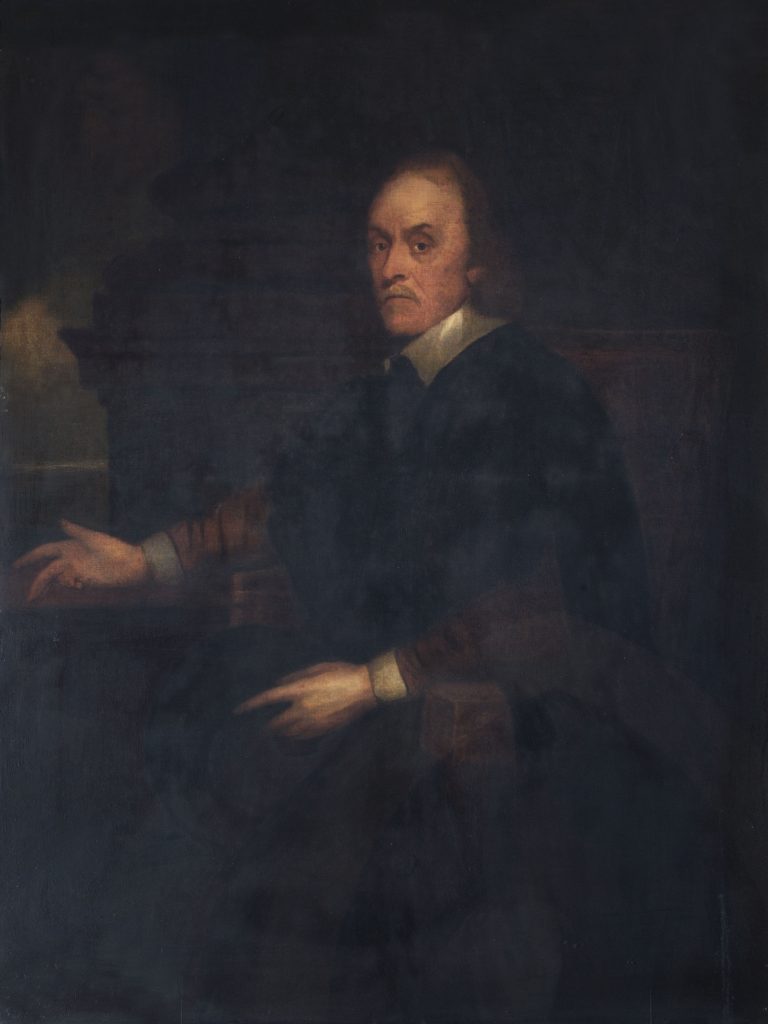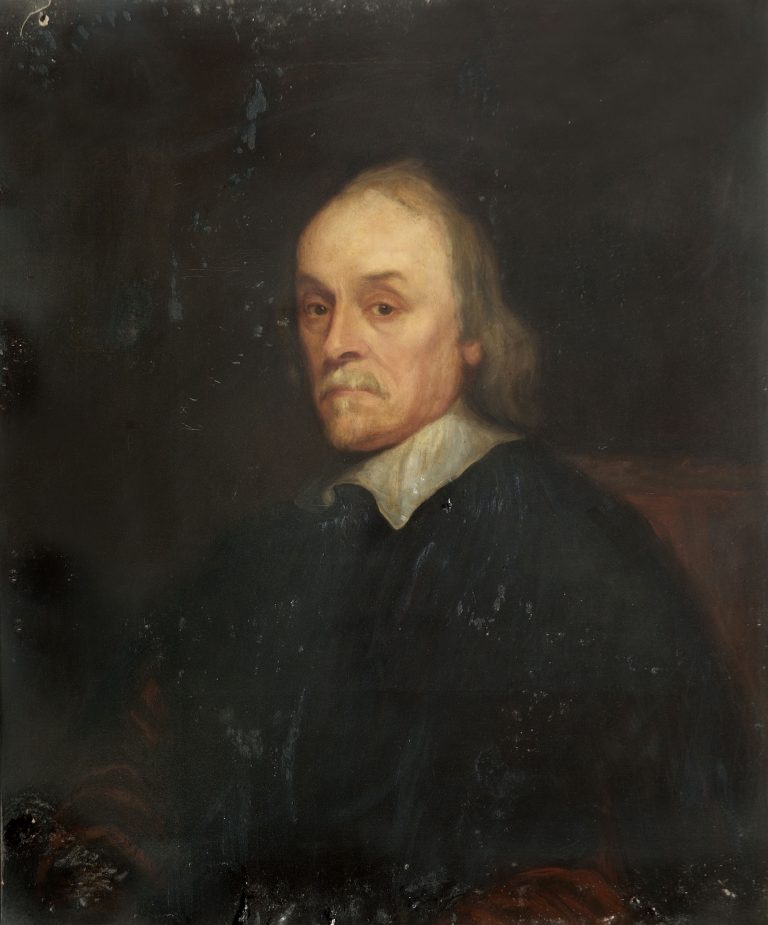17th Century
Images: Barts Health NHS Trust Archives
1609: William Harvey
Born in 1578, Harvey attended King’s Canterbury before going on to Gonville and Caius College, Cambridge. Gonville Hall, as it had been previously, received a Royal Charter in 1557, being refounded by John Caius, hence the name change. John Caius was a famous surgeon in his day and lived within the parish of St Bartholomew-the-Less, walking down the road to The Barber-Surgeons Hall on a weekly basis to deliver his lectures as the first Lecturer there in surgical anatomy.
Although Caius introduced some stringent exclusions for entry into the College (including being a Welshman!), he founded and developed it as a centre for excellence in the study of medicine. After this important first step, Harvey attended the University of Padua in 1599, where he studied under Fabricus ab Aquapendente, also known as Hieronymus Fabricius, the ‘Father of Embryology’. Fabricius’ teaching was much sought after as he had revolutionsed the teaching of anatomy through the design of the first permanent theatre for public anatomical dissections. Whilst Harvey was studying here, Fabricius was working on De Venarum Ostiolis (‘On The Valves of The Veins’, published 1603). This volume gives the first clear description of the semilunar valves of the veins. Harvey graduated as a Doctor of Medicine in 1602 and returned to England, receiving his medical degree from Cambridge before settling in London. He was appointed to the staff at St Bartholomew’s in 1607 and was appointed The Hospital’s Physician-in-Charge. In 1615, he was made a Lumleian Lecturer (after the post’s founder, Lord Lumley), a position lasting seven years and which involved travelling the country delivering lectures on general anatomy.
He continued to tend to his patients at Barts during this time. In 1616, he presented his first lecture on his theories on the circulation of the blood, delivering this lecture at Barts in 1619, in the face of much dissention. In 1618, he was appointed ‘Physician Extraordinary’ to James I. In 1628, he published his seminal work, ‘De Motu Cordis et Sanguinis in Animabilus’, which described for the first time the circulation of the blood as a complete closed circuit with dual components. This 70-page book was important for more than this alone, as it set out a basis for a new concept of physiology and demonstrated how scientific investigation in medicine should be done. Dissent continued and Harvey’s practice is reported to have waned as a consequence. The same cannot be said of his career, which continued from strength-to-strength.
He was appointed to Charles I as ‘Physician in Ordinary’. (The King is reported to never have left home without him!) For his part, this gave Harvey access to the carcasses of deer on Royal Hunts, which he used for cross-species studies of comparative anatomy.
During the Civil War, he remained in post, often at risk to himself. At one point his lodgings were raided by a mob that stole his possessions and scattered his papers. At the Battle of Edgehill, he is reputed to have protected the King’s children. He settled in Oxford when Charles made it his base of operations and new capital, only returning to London upon its surrender in 1645, the year in which he was made Warden of Merton College. He died from a haemorrhagic stroke in 1657.
1611: The death of Lady Ann Bodley
Lady Ann is buried at St Bartholomew-the-Less with a monument dedicated to her by her husband, the English diplomat and scholar, Thomas Bodley. The connection to Barts? Well, they lived just over the road but three degrees of separation is also at play here… In 1444, the library at Oxford University received 300 manuscripts and documents as a gift from Henry IV’s youngest son, Humphrey, then Duke of Gloucester. This generosity led to the building of a new library, but the reformation followed in hot pursuit a century later and the library was looted and left standing almost empty and unused. When Elizabeth I came to the throne, Thomas Bodley’s parents returned the family to England, after a self-imposed exile to Germany during Mary’s reign on account of being protestants. Bodley studied at Oxford and was subsequently appointed a fellow of Merton College, lecturing in ancient Greek. He left to become a successful diplomat in Europe in what were, diplomatically speaking, rather difficult times but returned to Oxford in 1598 and offered to restore the library and collect new volumes with which to furnish it. So successful was this enterprise that in 1739, a new building was required for the overflow of the now well-known Bodleian Library and so The Radcliffe Camera was designed and built.
1616: John Woodall
The first surgeon to be appointed to the East India Company and author of the ‘Surgeon’s Mate’, published in 1617 and the standard text for ship’s surgeons at the time. He was and still is best known for his experimental work on scurvy, which culminated in the understanding that it could be prevented by the ingestion of lemon juice. He also revolutionized the method of limb amputation, making it less painful by advocating amputation through the dead tissue below the line that demarcated the upper limit of infection. He had his dissenters but the proof was in the pudding – his patients survived where others did not.
He was a colleague and friend of Harvey but 22 years older. Such was the considered inferiority of the status of Barber-Surgeon compared to Physician, it took Woodall longer to be appointed. Woodall continued to work on the staff of the hospital until his death in 1643, aged 87. (A pretty good innings for the 17th Century. It must have been have all that lemon juice… )
1653-82: John Micklethwaite
Micklethwaite was appointed physician to Barts in 1653. In 1681, he treated Charles II at Windsor. The King recovered and Micklethwaite received a knighthood and became Physician-in-Ordinary to the King. He was also appointed as a Gulstonian Lecturer. (a medical lecture named for Theodore Goulston that began in 1639).
1653-70: Chistopher Terne
A Cambridge and Oxford graduate and one of the original Fellows of The Royal Society, he was appointed to the hospital in 1653 and assisted Micklethwaite. He lectured at The Barber Surgeons Hall and Samuel Pepys attended one of these. His lectures are preserved in The British Museum.
1662: Student record
Students were recorded as being present at Barts for the first time in 1662 but no systematic method of instruction had yet been developed.
1665: The Plague and a woman called Blague
The Plague hit London in 1665. Obviously the doctors at Barts stuck by their patients. Well … unfortunately not. (They ran for the hills!) The Matron at Barts at the time (1643-1675) was Margaret Blague, who was also the widow of a Barber-Surgeon. Matron Blague was made of sterner stuff than the squeamish physicians and surgeons and she and her staff stayed behind, continuing to tend to the sick.
1666: Fire of London
The Great Fire’s path was halted at Giltspur Street, where the entrance to the outpatients department now stands and is marked by a golden statue. The threat had however, been such that the hospital archive packed up many of the more valuable possessions into trunks and transported them to Hornsey for safe storage. Fortunately, although the fire reached the very gates of Barts, the hospital was undamaged. However, it suffered greatly as a consequence of lost revenue due to the loss of income-generating properties and due to large unpaid debts from treating the wounded soldiers returning from the Dutch Wars. By the start of the 18th Century, Barts was almost bankrupt and five of the fifteen wards had to be closed. The Governors set themselves to task and, through the development of new buildings surrounding the hospital to replace those lost in the fire, levied higher rents in an effort to settle their arrears.
1667: A new library
The Governors instructed the development of a library at the hospital for use by Governors and students.
1682-1708: Edward Browne
Browne attended Terne’s lectures and ended up marrying his lecturer’s daughter before returning as a physician to the hospital. He was later elected President of The Royal College of Physicians in 1694 for 10 years.
1697-1707: Robert Pitt
Pitt played a role in the controversy that followed the introduction of a dispensary by The Royal College of Physicians in 1696. Specifically he wrote on the low cost of useful medications, the excessive expense of the useless ones and the dangers of relying on too much medication. His first book ‘The Craft and Frauds of Physick Exposed’ (1702) was dedicated to the Governors of the hospital. He followed this up with ‘The Antidote, or the Preservative of Life and Health and the Restorative of Physick to its Sincerity and Perfection’ (1704) and ‘The Frauds and Villainies of the Common Practice of Physic Demonstrated to be Curable by the College’ (1705). His ideas were attacked by the physician Joseph Browne in his 1704 book, ‘The Modern Practice of Physick Vindicated from the Groundless Imputations of Dr. Pitt’. In Pitt’s defence, Browne had a good track record for choosing the wrong side, having been a major dissenter of Harvey’s circulatory research and being convicted twice of libelling Queen Anne’s administration.
Share…



